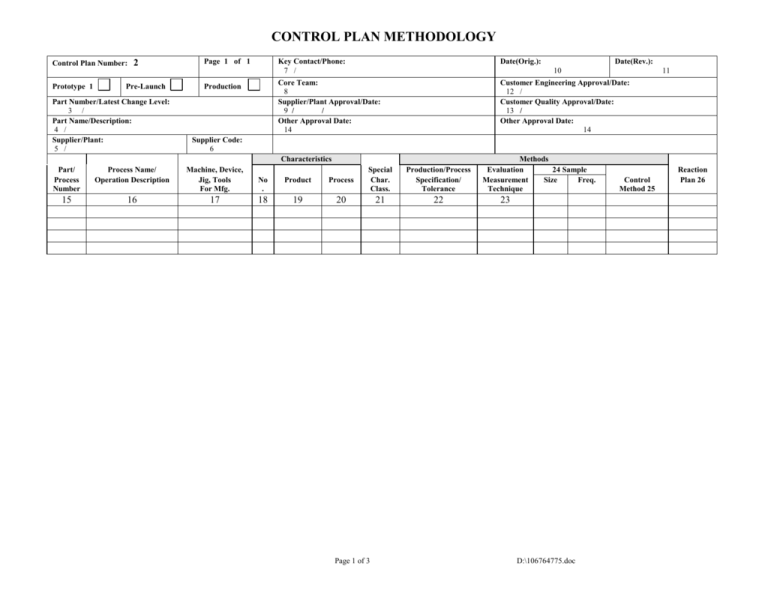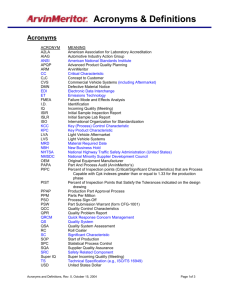Control Plan Number - Dayton
advertisement

CONTROL PLAN METHODOLOGY Control Plan Number: Prototype 1 2 Pre-Launch Part Number/Latest Change Level: 3 / Part Name/Description: 4 / Supplier/Plant: 5 / Page 1 of 1 Production Key Contact/Phone: 7 / Date(Orig.): Date(Rev.): Core Team: 8 Supplier/Plant Approval/Date: 9 / / Other Approval Date: 14 Customer Engineering Approval/Date: 12 / Customer Quality Approval/Date: 13 / Other Approval Date: 14 10 11 Supplier Code: 6 Characteristics Part/ Process Number Process Name/ Operation Description Machine, Device, Jig, Tools For Mfg. No . Product 15 16 17 18 19 Process Special Char. Class. Production/Process Specification/ Tolerance 20 21 22 Page 1 of 3 Methods Evaluation 24 Sample Measurement Size Freq. Technique 23 D:\106764775.doc Control Method 25 Reaction Plan 26 CONTROL PLAN METHODOLOGY 1) PROTOTYPE, PRE-LAUNCH, PRODUCTION: Indicate the appropriate category. Prototype- a description of the dimensional measurements, material and performance tests occurring during prototype build. Pre-launch- a description of the dimensional measurements, material and performance tests that will occur after Prototype and before normal production. Production: A comprehensive documentation of product/process characteristics, process controls, tests and measurement systems occurring during normal production. 2) CONTROL PLAN NUMBER: Enter the control plan document number used for tracking, if applicable. 3) PART NUMBER / LATEST CHANGE LEVEL: Enter the number of the system, subsystem or component being controlled. When applicable, enter the latest engineering change level and/or issue date from the drawing specification. 4) PART NAME/ DESCRIPTION: Enter the name and description of the product/process being controlled. 5) SUPPLIER/PLANT: Enter the name of the company and the appropriate division/plant/department preparing the control plan. 6) SUPPLIER CODE: Enter the identification number (Duns, Z-Coed, GSDB…) as requested by the procuring organization. 7) KEY CONTACT/ PHONE: Enter the name and telephone number of the primary contact responsible for the control plan. 8) CORE TEAM: Enter the name(s) and telephone number(s) of the individual(s) responsible for preparing the Control Plan to the latest revision. 9) SUPPLIER/PLANT APPROVAL/DATE: Obtain the responsible manufacturing plant approval (if required) 10) DATE (ORIG): Enter the date that the original control plan was compiled. 11) DATE (REV): Enter the date of the latest Control Plan updates. 12) CUSTOMER ENGINEERING APPROVAL/DATE: Obtain the responsible engineering approval (if required) 13) CUSTOMER QUALITY APPROVAL/DATE: Obtain the responsible supplier quality representative approval (if required) 14) OTHER APPROVAL/DATE: Obtain any other agreed upon approval (if required) 15) PART/PROCESS NUMBER: This item number is usually referenced from the Process Flow Chart. 16) PROCESS NAME/ OPERATION DESCRIPTION: All steps in the manufacturing of a system, subsystem, or component are described in a process flow diagram. Identify the process/operation name from the flow diagram that best describes the activity being addressed. 17) MACHINE, DEVICE, JIG, TOOLS FOR MANUFACTURING: For each operation that is describe, identify the processing equipment, e.g., machine, device, jig or other tools for manufacturing as appropriate. CHARACTERISTICS: A distinguishing feature, dimension or property of a process or its output (product) on which variable or attribute date can be collected. Use visual aids where applicable. 18) NUMBER: Enter a cross reference number from all applicable documents such as, but not limited to, process flow diagram, numbered blue print, FMEAs and sketches. 19) PRODUCT: Product Characteristics are the features or properties of a part, component or assembly that are described on drawings, or other primary engineering information. The Core Team should identify the Special Product Characteristics from all sources. All Special Characteristics must be listed on the Control Plan. In addition, the manufacturer may list other Product Characteristics for which process controls are routinely tracked during normal operations. Page 2 of 3 D:\106764775.doc CONTROL PLAN METHODOLOGY 20) PROCESS: Process Characteristics are the process variables (input variables) that have a cause and effect relationship with the identified Product Characteristic. A Process Characteristic can only be measured at the time it occurs. The Core Team should identify Process Characteristics for which variation must be controlled to minimized product variation. There could be one or more Process Characteristics listed for one Process Characteristic. In some processes one Process Characteristic may affect several Product Characteristics. 21) SPECIAL CHARACTERISTIC CLASSIFICATION: Use the appropriate classification as required by the OEM, to designate the type of special characteristic or this field can be left blank for other undesignated characteristics. Customers may use unique symbols to identify important characteristics, such as those that affect customer safety, compliance with regulations, function, fit, or appearance. These characteristics are variously termed "Critical," "Key," "Safety," or "Significant." 22) PRODUCT/PROCESS SPECIFICATION/ TOLERANCE: Specifications/ tolerance may be obtained from various engineering documents, such as, but not limited to, drawings, design reviews, material standard, computer aided design data, manufacturing, and/or assembly requirements. 23) EVALUATION/MEASUREMENT TECHNIQUE: This column identifies the measurement system being used. This could include gages, fixtures, tools, and/or test equipment required to measure the part/process/manufacturing equipment. An analysis of the linearity, reproducibility, repeatability, stability and accuracy of the measurement system should be done prior to relying on a measurement system and improvements made accordingly. 24) SAMPLE SIZE/ FREQUENCY: When sampling is required list the corresponding sample size and frequency. 25) CONTROL METHOD: This column contains a brief description of how the operation will be controlled, including procedure numbers where applicable. The control method utilized should be based on effective analysis of the process. The control method is determined by the type of process that exists. Operations may be controlled by, but are not limited to, Statistical Process Control, inspection, attribute data, mistake-proofing, (automated/non-automated), and sampling plans. The Control Plan descriptions should reflect the planning and strategy being implemented in the manufacturing process. If elaborate control procedures are used, the plan will typically reference the procedure document by a specific identification name and/or number. The method of control should be continually evaluated for effectiveness of process control. For example, significant changes in the process or process capability should lead to an evaluation of the control method. 26) REACTION PLAN: The reaction plan specifies the corrective actions necessary to avoid producing nonconforming products or operating out of control. The actions should normally be the responsibility of the people closest to the process, the operator, jobsetter, or supervisor and be clearly designated in the plan. Provisions should be made for documenting. In all cases, suspect and nonconforming products must be clearly identified and quarantined, and disposition made by the responsible person designated in the reaction plan. This column may also refer to a specific reaction plan number and identify the person responsible for the reaction plan. Reprinted with permission from the APQP MANUAL (DaimlerChrysler, Ford, General Motors Supplier Quality Requirements Task Force) Page 3 of 3 D:\106764775.doc








